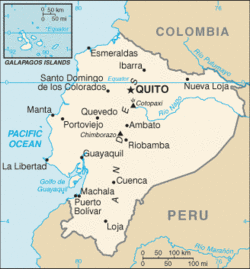Welcome to the Virtual Education Wiki ~ Open Education Wiki
Ecuador
Original Re.ViCa entry by Paul Bacsich assisted by Gertjan and with desk research by Iris Velasquez Noguera
For entities in Ecuador see Category:Ecuador
Partners and experts situated in Ecuador
None.
Ecuador in a nutshell
Ecuador, officially the Republic of Ecuador (Spanish: República del Ecuador), literally, "Republic of the equator" is a representative democratic republic in South America, bordered by Colombia on the north, by Peru on the east and south, and by the Pacific Ocean to the west. It is one of only two countries in South America (with Chile) that does not have a border with Brazil. The country also includes the Galápagos Islands in the Pacific, about 965 kilometres (600 mi) west of the mainland. Ecuador straddles the equator, from which it takes its name, and has an area of 256,371 square kilometres (98,985 sq mi). Its capital city is Quito; its largest city is Guayaquil.
Its population is around 14 million.
Ecuador is divided into 24 provinces (provincias), each with its own administrative capital. It has three main geographic regions, plus an insular region in the Pacific Ocean:
- La Costa, or the coast, comprises the low-lying land in the western part of the country, including the Pacific coastline.
- La Sierra ("the highlands") is the high-altitude belt running north-south along the center of the country, its mountainous terrain dominated by the Andes mountain range.
- La Amazonía, also known as El Oriente ("the east"), comprises the Amazon rainforest areas in the eastern part of the country, accounting for just under half of the country's total surface area, though populated by less than 5% of the population.
- Región Insular, the region comprising the Galápagos Islands, some 1,000 kilometers (620 mi) west of the mainland in the Pacific Ocean.
Ecuador's population is ethnically diverse. The largest ethnic group (as of 2007) is the Mestizos, who are the mixed descendants of Spanish colonists and indigenous Indians and who constitute less than 55% of the population. Amerindians account for around 25% of the current population. Whites, mainly criollos, the unmixed descendants of early Spanish colonists, as well as immigrants from other European countries, account for about 15% of the population. The small Afro-Ecuadorian minority, including Mulattos and zambos, largely based in Esmeraldas and Imbabura provinces, make up 5% of the population.
Education in Ecuador
The public education system is free at the point of delivery, and attendance is mandatory from ages five to 14.
Provision of public schools falls far below the levels needed, and class sizes are often very large, and families of limited means often find it necessary to pay for education. In rural areas, only 10% of the children go on to high school. The Ministry of Education states that the mean number of year completed as 6.7.
Ecuador has 61 universities, many of which offer graduate degrees, although only 87% of the faculty in public universities possess graduate degrees. About 300 higher institutes offer two to three years of post-secondary vocational or technical training.
Schools in Ecuador
Further and Higher education in Ecuador
Universities
There are said to be 61 universities. A listing of some of them is below: (source: http://www.4icu.org/ec/universities-ecuador.htm)
- Universidad de Cuenca, Cuenca
- Universidad del Azuay, Cuenca
- Universidad Politécnica Salesiana del Ecuador: Cuenca, Guayaquil, Quito
- Universidad Estatal de Bolívar, Guaranda
- Escuela Superior Politécnica del Litoral: Guayaquil, Quito, Samborondon, Daule
- Universidad Agraria del Ecuador: Guayaquil, Milagro
- Universidad Católica de Santiago de Guayaquil: Guayaquil
- Universidad de Guayaquil, Guayaquil
- Universidad Laica Vicente Rocafuerte de Guayaquil, Guayaquil
- Universidad Santa María, Guayaquil
- Universidad Técnica del Norte, Ibarra
- Universidad Técnica de Cotopaxi, Latacunga
- Universidad Nacional de Loja, Loja
- Universidad Técnica Particular de Loja, Loja
- Universidad Laca Eloy Alfaro de Manabi, Manabí
- Universidad Técnica de Manabí, Manabí
- Universidad Técnica Estatal de Quevedo: Quevedo, La Mana, Balzar, Salcedo, Puyo, Patate
- Escuela Politécnica Nacional, Quito
- Pontificia Universidad Católica del Ecuador, Quito
- Universidad Andina Simón Bolívar: Quito, La Paz
- Universidad Central del Ecuador, Quito
- Universidad de Especialidades Turísticas Quito
- Universidad del Pacifico Quito, Guayaquil, Cuenca
- Universidad Internacional del Ecuador, Quito
- Universidad Internacional SEK-Ecuador, Quito
- Universidad San Francisco de Quito Quito, Cumbaya
- Universidad Tecnológica América, Quito
- Universidad Tecnológica Equinoccial, Quito
- Universidad Tecnológica Indoamérica, Quito
- Escuela Superior Politecnica de Chimborazo, Riobamba
- Universidad Nacional de Chimborazo Riobamba, Guano
- Universidad de Especialidades del Espíritu Santo, Samborondón
- Escuela Politécnica del Ejercito, Sangolquí
- Universidad Técnica de Ambato, Tungurahua
Polytechnics in Ecuador
There are about 300 higher institutes offer two to three years of post-secondary vocational or technical training.
Colleges in Ecuador
Education reform
Schools
Post-secondary
Administration and finance
Schools
Post-secondary
Quality assurance
Schools
Post-secondary
Information society
ICT in education initiatives
Virtual initiatives in schools
Virtual initiatives in post-secondary education
Universidad Tecnica Particular de Loja
The Universidad Técnica Particular de Loja (UTPL) is presently an autonomous organisation in Loja, Ecuador. UTPL provides both on-campus and distance education.
UTPL was created by presidential decree in 1971 and administered by the government until October 1997. Originally (until 1987) it was called the Open University of Loja. Today, it is run by missionaries and views itself as 'an educational institution with a social purpose'. A non-profit organisation financed by the Ecuadorian State, it was a pioneer of distance learning in Latin America, with distance learning provision available since 1976.
Its web site is at http://www.utpl.edu.ec/ingles/
Lessons learnt
References
For OER policies and projects in Ecuador see Ecuador/OER
